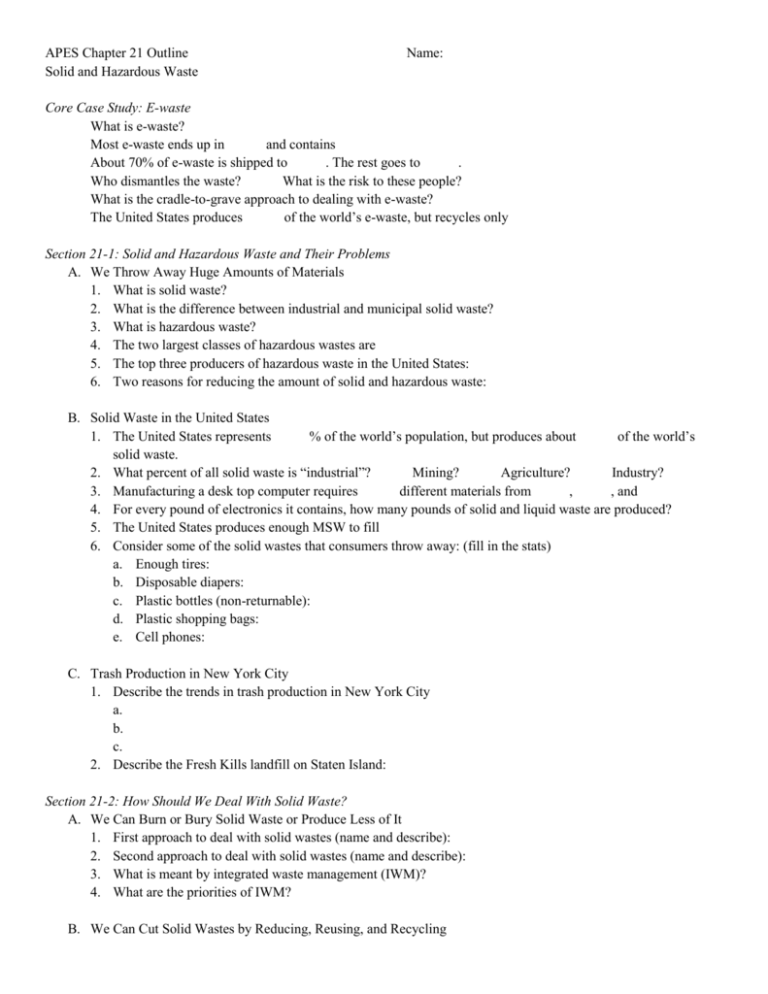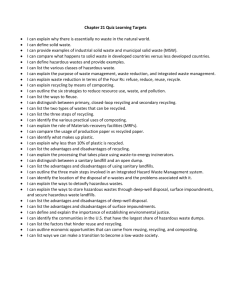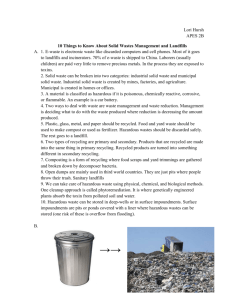Chapter 21 Outline
advertisement

APES Chapter 21 Outline Solid and Hazardous Waste Name: Core Case Study: E-waste What is e-waste? Most e-waste ends up in and contains About 70% of e-waste is shipped to . The rest goes to . Who dismantles the waste? What is the risk to these people? What is the cradle-to-grave approach to dealing with e-waste? The United States produces of the world’s e-waste, but recycles only Section 21-1: Solid and Hazardous Waste and Their Problems A. We Throw Away Huge Amounts of Materials 1. What is solid waste? 2. What is the difference between industrial and municipal solid waste? 3. What is hazardous waste? 4. The two largest classes of hazardous wastes are 5. The top three producers of hazardous waste in the United States: 6. Two reasons for reducing the amount of solid and hazardous waste: B. Solid Waste in the United States 1. The United States represents % of the world’s population, but produces about of the world’s solid waste. 2. What percent of all solid waste is “industrial”? Mining? Agriculture? Industry? 3. Manufacturing a desk top computer requires different materials from , , and 4. For every pound of electronics it contains, how many pounds of solid and liquid waste are produced? 5. The United States produces enough MSW to fill 6. Consider some of the solid wastes that consumers throw away: (fill in the stats) a. Enough tires: b. Disposable diapers: c. Plastic bottles (non-returnable): d. Plastic shopping bags: e. Cell phones: C. Trash Production in New York City 1. Describe the trends in trash production in New York City a. b. c. 2. Describe the Fresh Kills landfill on Staten Island: Section 21-2: How Should We Deal With Solid Waste? A. We Can Burn or Bury Solid Waste or Produce Less of It 1. First approach to deal with solid wastes (name and describe): 2. Second approach to deal with solid wastes (name and describe): 3. What is meant by integrated waste management (IWM)? 4. What are the priorities of IWM? B. We Can Cut Solid Wastes by Reducing, Reusing, and Recycling 1. Seven Strategies with which industries and communities can reduce resource use, waste, and pollution: a. b. c. d. e. f. g. Section 21-3: Why is Reusing and Recycling Materials So Important? A. Reuse is an Important Way to Reduce Solid Waste and Pollution and to Save Money 1. Reuse involves 2. In developing countries, the downside of reuse is 3. Traditional forms of reuse include and B. Use of Refillable Containers 1. Describe the trends: C. There are Two Types of Recycling 1. Primary (closed loop): 2. Secondary (open loop): 3. The two types of waste that can be recycled: and 4. Switzerland and Japan recycle % of their MSW while the U.S. recycles % D. We Can Mix or Separate Household Solid Waste for Recycling 1. What are NRFs? 2. It makes more environmental and economic sense for households to 3. To promote separation of wastes, many communities use a in which E. We Can Copy Nature and Recycle Biodegradable Solid Wastes 1. Describe what composting is: 2. The United States has about municipal composting programs that recycle about F. Recycling Paper 1. About of the world’s tree harvest is used to make pulp. 2. Describe the trends: 3. What pollution problems are associated with making paper? How are they being addressed? G. Recycling Plastics 1. What are plastics? 2. What are the problems associated with plastic containers? a. b. 3. What are the three reasons attributed to the low percentage of plastics recycled? a. b. c. H. Recycling Has Advantages and Disadvantages of yard waste. 1. Three advantages: a. b. c. d. 2. Three disadvantages: a. b. c. I. We Can Encourage Reuse and Recycling (Three ways): 1. 2. 3. Section 21-4: What are the Advantages and Disadvantages of Burning or Burying Solid Waste? A. Burning Solid Waste Has Advantages and Disadvantages 1. What are waste-to-energy incinerators? 2. Three advantages: a. b. c. 3. Three disadvantages: a. b. c. B. Burying Solid Waste Has Advantages and Disadvantages 1. Two types of landfills: and 2. Describe them: a. b. 3. Three advantages: a. b. c. 4. Three disadvantages: a. b. c. Section 21-5: How Should We Deal with Hazardous Waste? A. We Can Use Integrated Management of Hazardous Waste 1. The U.S. National Academy of Sciences establishes 3 levels of priorities for dealing with hazardous waste: , , and 2. How does Europe deal with hazardous waste? B. Recycling E-Waste 1. What are the hazards to workers? 2. What happens to leftover parts? 3. What are HP and Dell doing in response to this problem? C. We Can Detoxify Hazardous Wastes 1. What are the physical ways of detoxifying HW? 2. What is one chemical method? 3. How are nanomagnets used? 4. What is bioremediation? 5. What is phytoremediation? 6. What does a plasma arc torch do? D. We Can Store Some Forms of Hazardous Waste 1. Advantages of deep well disposal: and 2. Disadvantages: and 3. Advantages of surface impoundments: and 4. Disadvantages: and E. Hazardous Waste Regulation in the United States 1. What is RCRA? 2. What is ‘cradle-to-grave’? 3. What is CERCLA (Superfund)? Section 21-6: How Can We Make the Transition to a More Sustainable Low-Waste Society? A. Grassroots Action Has Led to Better Waste Management 1. What is meant by NIMBY? B. International Treaties 1. What does the ’12 POPs’ mean? 2. What chemicals are in the ‘dirty dozen’? C. We Can Make the Transition to Low-Waste Societies 1. To prevent pollution and reduce waste, many scientists urge us to follow these key principle: a. b. c. d. e. f. g.









